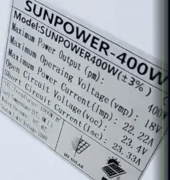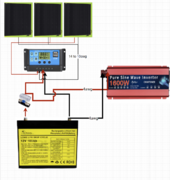I get It, and everyone is trying to help but they muddy your issues because they haven't taken the time read and understand all your posts and your situation.
@Hedges is a good one to listen to once he gets what you need. And I am sure he will pipe up if he disagrees with anything I say. There are others as long as they stay on topic and don't want to totally redesign and start over.
Ok, long post - read it all and think about it - ask any questions -
If you will stick with me I will stick with you. When I give up is when you keep changing what you are doing and not listening to the advice that applies specifically to you. People do tend to ramble.
If you need to save up just get what you can and hook nothing up yet.
Order this battery - looks like the 12v150ah version is cheapest for some reason. Make sure to select it. There are also 12v100ah and two 24v versions on the same page.
battery for solar panel 12v 100ah. lithium batteries 12v for solar. sinopoly lifepo4 battery 90ah. lithium battery 12v for solar. lithium ion battery 12v 200ah. Lithium iron phosphate battery is characterised by outstanding durability, current performance and charging speed. It also has a longer...

www.lazada.com.ph
Order this fuse - it will keep you safe - not ideal but the best I could find on the site - you want the 80amp version. If you don't get a spare you will want to get one in future. You don't need the holder again, just a replacement fuse.
MINIFRUT. heavy duty fuse holder for car. 2 way power distribution block. motorcycle fuse box with fuse. farad capacitor for car audio. parametric equalizer 12v sale. Brand new and high quality. Allows to use one power wire to have protective circuits. Helps to protect the device from over...

www.lazada.com.ph
This is a future purchase - don't order now. - it will replace the PWM controller so you can get more power from the sun into your battery.
PowMr. snadi inverter 1kw 12v on sale. solar panel set home full set. mppt controller with inverter. snadi solar charge controller. epever mppt charge controller. Model POW-Keeper1220(20A POW-Keeper1230(30A POW-Keeper1240(40A). Type MPPT. Rated voltage: 12/24V Auto. System voltage: 12/24V...

www.lazada.com.ph
This is probably what you should have to pay for a small inverter --- I am not saying buy this -- just an example - it does 800watts continuous which would cover your computer, monitor, and fridge
Note: (1)12V inverter can only connect to 12V batteries (working voltage range: 10.5V~15.5V), 24V inverter can only connect to 24V batteries (working voltage range: 19.5V~28V). (2)When using the inverter, the power of the electrical appliance shall not exceed the continuous power of the...

www.lazada.com.ph
Questions section:
Here is a diagram of what I think you should should be going for. I did put in the 80amp fuse, but I didn't put in any fuses on the solar panel lines. what questions do you have about it?
Three solar panels all wired individually down to the PWM. The pluses and minuses will be grouped and insert into the panel holes.
PWM wired to the battery negative post and the fuse holder. The positive wire should have a fuse in it, but dunno what size until you post a picture.
Inverter wired to the negative battery post and the fuse holder.
The idea is all the power in and out of the battery will have to go through the 80 amp fuse. Once you post a picture of the PWM charge controller we can size the fuse for that.
Your panels say 400watt by sunpower, but from the earlier discussion they appear to be to small. I think someplace you measured the physical size, can you repost or dig it out of the chain and repost. To help figure that out, assuming you still have wires from the roof connected to them measure the voltage open circuit across them. As in with them not attached to anything, setting to DC and start with the range at the highest setting and bring it down until you get a reading. Now, ideally we would measure the short circuit current but if the panel puts out more than your meter can handle it would damage it. Take a picture of your panels and post it. Just as close as you can get without risking life. Of the top as they lay.
And I just had an idea, take the wires from one panel and touch them to a regular incandecnt bulb. If they are what I think you will get a weak glow. If they are anywhere near what they are marked you will get a bright glow.
What size wire and connectors do you have on hand? Can you lay it across a ruler and post a picture? For the wires to the panels each should have its own pair and somewhere from 14 to 10awg. For the wire to the inverter it should be 4awg. 4awg should have wires in it that are about as big around as a regular pencil or just a bit smaller around than your pinky finger. Ideally this will be battery or welding wire so that the wires that make up the bundle are fine like hairs on your head, well almost.
Also take a picture front and back of your PWM so we can see it. It should look like this or similar
XIPIN. Solar Panel 10000Watts Complete Set for Home: Environmentally friendly, non-toxic, anti-aging, and long lifespan. Solar Set Package with Inverter and Battery: Including li-ion batteries, solar charger, usb cable, etc. (battery not included), built-in high-efficiency lithium battery, it...

www.lazada.com.ph
Don't hook it up until we have pictures





